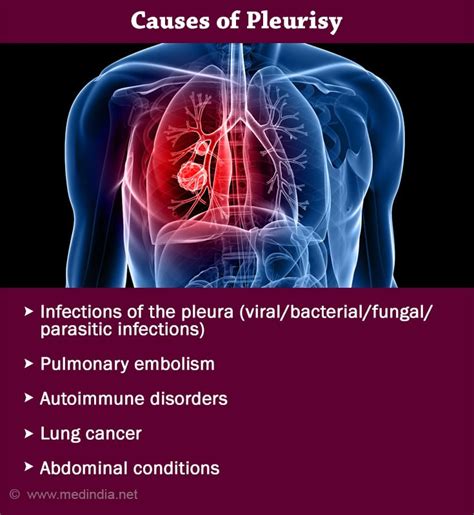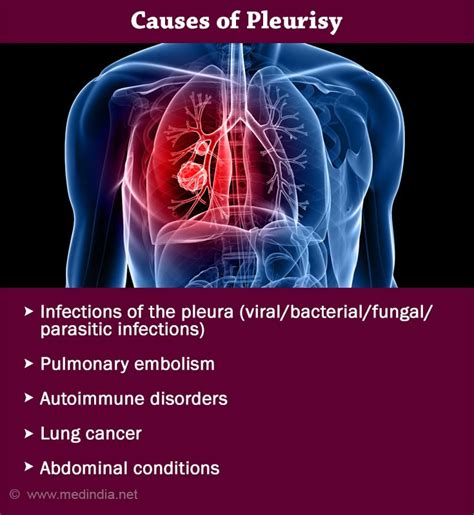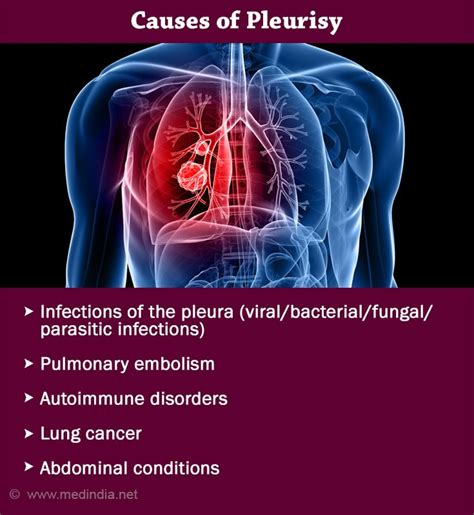Intro
Discover what is pleuritis, a condition causing inflammation of the pleura, with symptoms like chest pain and difficulty breathing, and learn about its types, including pleurisy and pulmonary pleuritis, for effective diagnosis and treatment.
Pleuritis, also known as pleurisy, is a condition characterized by inflammation of the pleura, which are the two layers of tissue that surround the lungs and line the chest cavity. This inflammation can cause sharp chest pain, particularly when breathing, coughing, or sneezing, and can be accompanied by other symptoms such as fever, cough, and shortness of breath. Pleuritis can be caused by a variety of factors, including viral or bacterial infections, pulmonary embolism, pneumonia, and autoimmune disorders. Understanding the causes, symptoms, and treatment options for pleuritis is essential for managing the condition and preventing complications.
The pleura play a crucial role in facilitating smooth movement of the lungs during breathing, and any inflammation or irritation of these tissues can lead to significant discomfort and respiratory distress. Pleuritis can affect anyone, regardless of age or health status, although certain individuals, such as those with a history of lung disease or smokers, may be at higher risk. The condition can range from mild to severe, and in some cases, it may resolve on its own with rest and over-the-counter pain medication. However, in more severe cases, medical attention is necessary to treat the underlying cause and manage symptoms.
Pleuritis is often diagnosed based on a combination of physical examination, medical history, and diagnostic tests such as chest X-rays, computed tomography (CT) scans, and pleural fluid analysis. Treatment for pleuritis depends on the underlying cause and may involve antibiotics for bacterial infections, antiviral medications for viral infections, or other medications to manage symptoms and reduce inflammation. In some cases, hospitalization may be necessary to provide oxygen therapy, pain management, and close monitoring. Early recognition and treatment of pleuritis are critical to preventing complications, such as respiratory failure, and improving outcomes.
Causes of Pleuritis

Pleuritis can be caused by a variety of factors, including infections, injuries, and underlying medical conditions. Some of the most common causes of pleuritis include viral infections, such as influenza or coronavirus, bacterial infections, such as pneumonia or tuberculosis, and fungal infections, such as aspergillosis or histoplasmosis. Pulmonary embolism, which occurs when a blood clot lodges in the lungs, can also cause pleuritis, as can autoimmune disorders, such as rheumatoid arthritis or lupus. In some cases, pleuritis may be caused by a chest injury, such as a rib fracture or blunt trauma to the chest.
Other potential causes of pleuritis include cancer, such as lung cancer or mesothelioma, and certain medications, such as antibiotics or anti-inflammatory drugs. In some cases, the cause of pleuritis may be unknown, and the condition may be referred to as idiopathic pleuritis. Understanding the underlying cause of pleuritis is essential for developing an effective treatment plan and preventing complications.
Types of Pleuritis
There are several types of pleuritis, including dry pleuritis, which is characterized by inflammation of the pleura without fluid accumulation, and wet pleuritis, which is characterized by inflammation of the pleura with fluid accumulation. Other types of pleuritis include fibrinous pleuritis, which is characterized by the accumulation of fibrin, a protein, in the pleural space, and empyemic pleuritis, which is characterized by the accumulation of pus in the pleural space.Symptoms of Pleuritis

The symptoms of pleuritis can vary depending on the underlying cause and severity of the condition. Common symptoms of pleuritis include sharp chest pain, particularly when breathing, coughing, or sneezing, and shortness of breath or difficulty breathing. Other symptoms may include fever, cough, fatigue, and muscle aches. In some cases, pleuritis may cause a dry, hacking cough or a cough that produces yellow or green mucus.
The chest pain associated with pleuritis can be severe and may be described as sharp, stabbing, or burning. The pain may worsen with deep breathing, coughing, or sneezing and may improve with rest or pain medication. In some cases, the pain may radiate to the shoulder or back. Other symptoms of pleuritis may include anxiety or panic, particularly if the condition is severe or if the individual has a history of respiratory disease.
Diagnosing Pleuritis
Diagnosing pleuritis typically involves a combination of physical examination, medical history, and diagnostic tests. The healthcare provider may listen to the lungs with a stethoscope to check for abnormal sounds, such as a pleural rub, which is a creaking or grating sound that occurs when the inflamed pleura rub against each other. The healthcare provider may also perform a chest X-ray or computed tomography (CT) scan to visualize the lungs and pleura.Other diagnostic tests that may be used to diagnose pleuritis include pleural fluid analysis, which involves removing a sample of fluid from the pleural space and analyzing it for signs of infection or inflammation, and blood tests, which can help identify the underlying cause of the condition. In some cases, a thoracentesis, which involves removing excess fluid from the pleural space, may be necessary to relieve symptoms and improve breathing.
Treatment Options for Pleuritis

Treatment for pleuritis depends on the underlying cause and severity of the condition. In some cases, the condition may resolve on its own with rest and over-the-counter pain medication. However, in more severe cases, medical attention is necessary to treat the underlying cause and manage symptoms. Treatment options for pleuritis may include antibiotics for bacterial infections, antiviral medications for viral infections, and anti-inflammatory medications to reduce inflammation and relieve symptoms.
Other treatment options for pleuritis may include oxygen therapy to improve breathing, pain management with prescription pain medication, and thoracentesis to remove excess fluid from the pleural space. In some cases, hospitalization may be necessary to provide close monitoring and supportive care. It is essential to follow the healthcare provider's treatment plan and attend follow-up appointments to ensure that the condition is properly managed and to prevent complications.
Managing Symptoms of Pleuritis
Managing symptoms of pleuritis is essential to improving quality of life and preventing complications. Some ways to manage symptoms of pleuritis include getting plenty of rest, staying hydrated by drinking plenty of fluids, and using over-the-counter pain medication to relieve chest pain and reduce inflammation. It is also essential to avoid strenuous activities, such as heavy lifting or bending, and to avoid smoking and secondhand smoke.Other ways to manage symptoms of pleuritis include using a humidifier to add moisture to the air, which can help relieve cough and congestion, and practicing relaxation techniques, such as deep breathing or meditation, to reduce stress and anxiety. It is also essential to follow a healthy diet and to get regular exercise to improve overall health and well-being.
Complications of Pleuritis

Pleuritis can lead to several complications, particularly if left untreated or if treatment is delayed. Some potential complications of pleuritis include respiratory failure, which can occur if the condition is severe or if the individual has a history of respiratory disease. Other complications may include pneumonia, which can develop if bacteria enter the lungs, and pulmonary embolism, which can occur if a blood clot forms in the lungs.
Other potential complications of pleuritis include empyema, which is a collection of pus in the pleural space, and fibrothorax, which is a condition characterized by scarring of the pleura. In some cases, pleuritis can lead to chronic pain and disability, particularly if the condition is severe or if treatment is delayed. It is essential to seek medical attention immediately if symptoms of pleuritis occur or if the condition worsens over time.
Preventing Pleuritis
Preventing pleuritis is essential to reducing the risk of complications and improving outcomes. Some ways to prevent pleuritis include getting vaccinated against flu and pneumonia, practicing good hygiene, such as washing hands frequently, and avoiding close contact with individuals who have respiratory infections. It is also essential to avoid smoking and secondhand smoke, as these can increase the risk of respiratory disease.Other ways to prevent pleuritis include getting regular exercise, eating a healthy diet, and managing stress and anxiety. It is also essential to seek medical attention immediately if symptoms of pleuritis occur or if the condition worsens over time. By taking these steps, individuals can reduce their risk of developing pleuritis and improve their overall health and well-being.
What is pleuritis?
+Pleuritis, also known as pleurisy, is a condition characterized by inflammation of the pleura, which are the two layers of tissue that surround the lungs and line the chest cavity.
What are the symptoms of pleuritis?
+The symptoms of pleuritis can vary depending on the underlying cause and severity of the condition, but common symptoms include sharp chest pain, shortness of breath, and fever.
How is pleuritis diagnosed?
+Pleuritis is typically diagnosed based on a combination of physical examination, medical history, and diagnostic tests, such as chest X-rays, computed tomography (CT) scans, and pleural fluid analysis.
What are the treatment options for pleuritis?
+Treatment for pleuritis depends on the underlying cause and severity of the condition, but may include antibiotics, antiviral medications, anti-inflammatory medications, and oxygen therapy.
Can pleuritis be prevented?
+Yes, pleuritis can be prevented by getting vaccinated against flu and pneumonia, practicing good hygiene, avoiding close contact with individuals who have respiratory infections, and avoiding smoking and secondhand smoke.
We hope this article has provided you with a comprehensive understanding of pleuritis, including its causes, symptoms, diagnosis, treatment options, and prevention. If you have any further questions or concerns, please do not hesitate to comment below or share this article with others who may find it helpful. Remember to always prioritize your health and well-being, and seek medical attention immediately if you experience any symptoms of pleuritis or if you have any concerns about your respiratory health.
